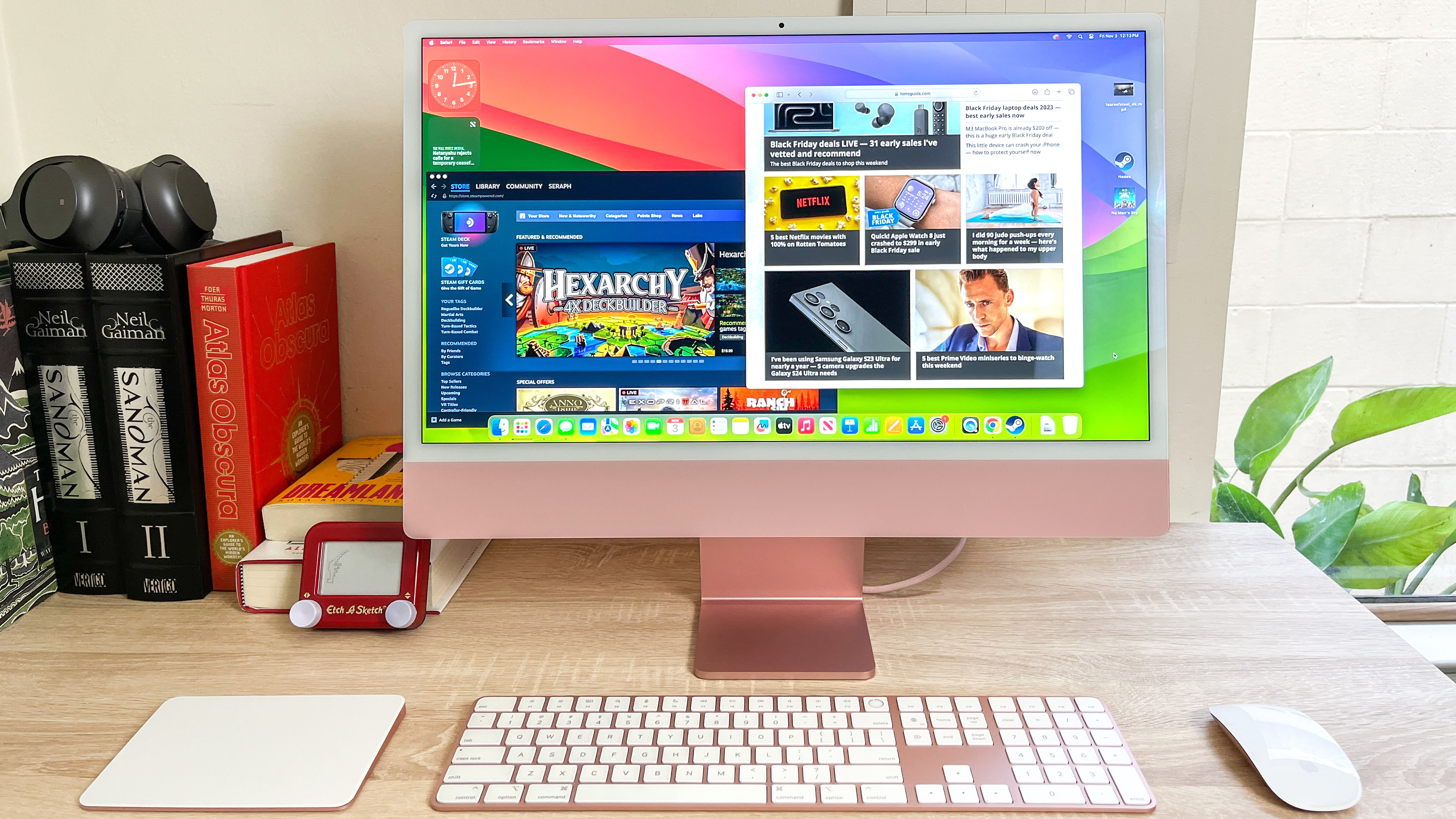
The new Apple iMac M3 ($1,299 to start) looks an awful lot like its 2021 predecessor, but under the hood this all-in-one is powered by the all-new Apple M3 chip.
That cutting-edge slice of Apple silicon gives the 24-inch iMac a much-needed shot in the arm, since the previous model was powered by 2020's Apple M1 chip. That model's still fine for basic work, but the M3 upgrade gives the 2023 iMac more power and more features than before, including upgraded wireless connectivity, better image processing and support for modern graphics tech like hardware-accelerated ray tracing.
From looks alone you'd be hard-pressed to tell the two models apart. Apple's new iMac M3 comes in the same seven colors as its predecessor, has basically the same price and the same flaws as the 2021 model — which despite its foibles was one of the best computers of the year.
Does this all-new M3 edition of Apple's all-in-one still deserve to make that list in 2023? I think it does, and in this iMac M3 review, I'll walk you through why.
Apple iMac M3 review: Specs
Apple iMac M3 review: Price and availability
- $1,299 to start, $1,499 minimum to get all 7 colors and full port array
- Tops out at close to $3k for a fully maxed-out iMac M3
The new M3-powered 24-inch iMac is available to order on Apple’s website at a starting price of $1,299, with units slated to start arriving to customers and stores Tuesday, November 7. If you'd like one with a VESA mount adapter on the back for mounting it to a wall or monitor arm, you have to buy a iMac M3 with a VESA adapter instead of a stand.
The entry-level $1,299 iMac M3 comes with 2 Thunderbolt 4 ports, 256GB of storage, 8GB of RAM, and an Apple M3 chip with an 8-core CPU and 8-core GPU. That's a more powerful chip with an extra GPU core than you got for the same price on the 2021 iMac, which is nice to see.
However, these entry-level iMacs once again ship with a Magic Keyboard that doesn’t support Touch ID, and they still only come in 4 colors rather than the 7 available on higher-end iMacs. I hated this sales strategy when Apple employed it on the 2021 iMac, so it's once again distressing and confusing to see that customers are basically strong-armed into paying more for the more expensive models of iMac if they want one in orange, yellow or purple. Are these colors somehow incompatible with the entry-level iMac?
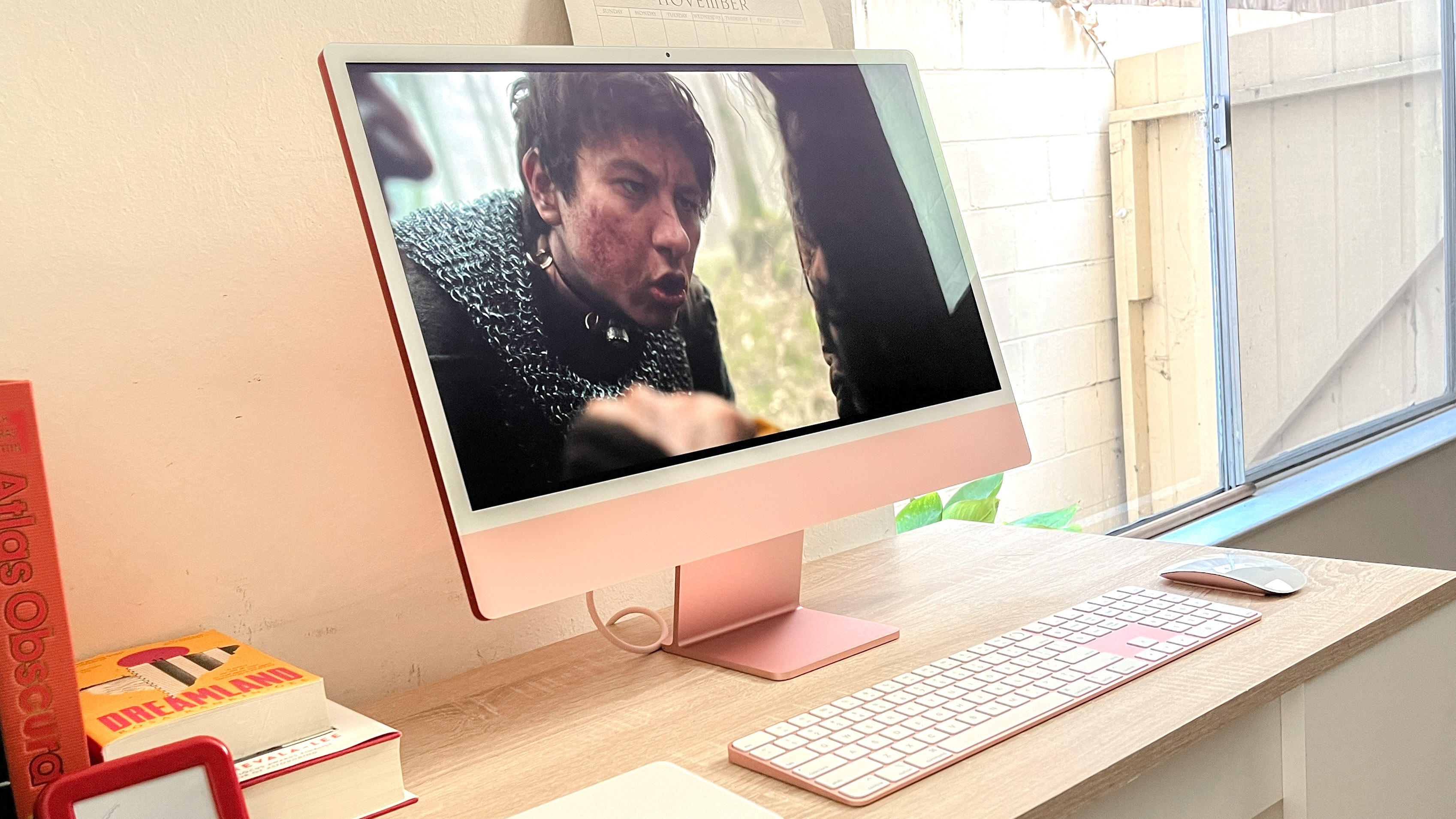
Apple sure seems to think so, because for $1,499 you can get an upgraded iMac M3 with an 8-core CPU, 10-core GPU, and your choice of seven colors: blue, green, pink, silver, yellow, orange or purple. On this model and all of the more expensive models, you also get a Gigabit Ethernet port and two additional USB-C ports on the back, for a total of two Thunderbolt 4 ports and two USB-C ports.
You can't upgrade the M3 chip in the iMac M3 past an 8-core CPU and 10-core GPU, but you can pay more to upgrade the RAM and storage if you want more memory. You can get a maxed-out iMac M3 with as much as 24GB of RAM and 2TB of SSD storage — that model will cost you $2,699.
And while every iMac M3 comes with an Apple Magic Mouse and Magic Keyboard included (though again, the $1,299 models come with keyboards lacking Touch ID support unless you pay $50 to upgrade), you'll need to pay an extra $50 if you want a Magic Trackpad. I have hand and wrist issues and find the Magic Mouse basically unusable, so I'm grateful Apple included a Trackpad with our review unit.
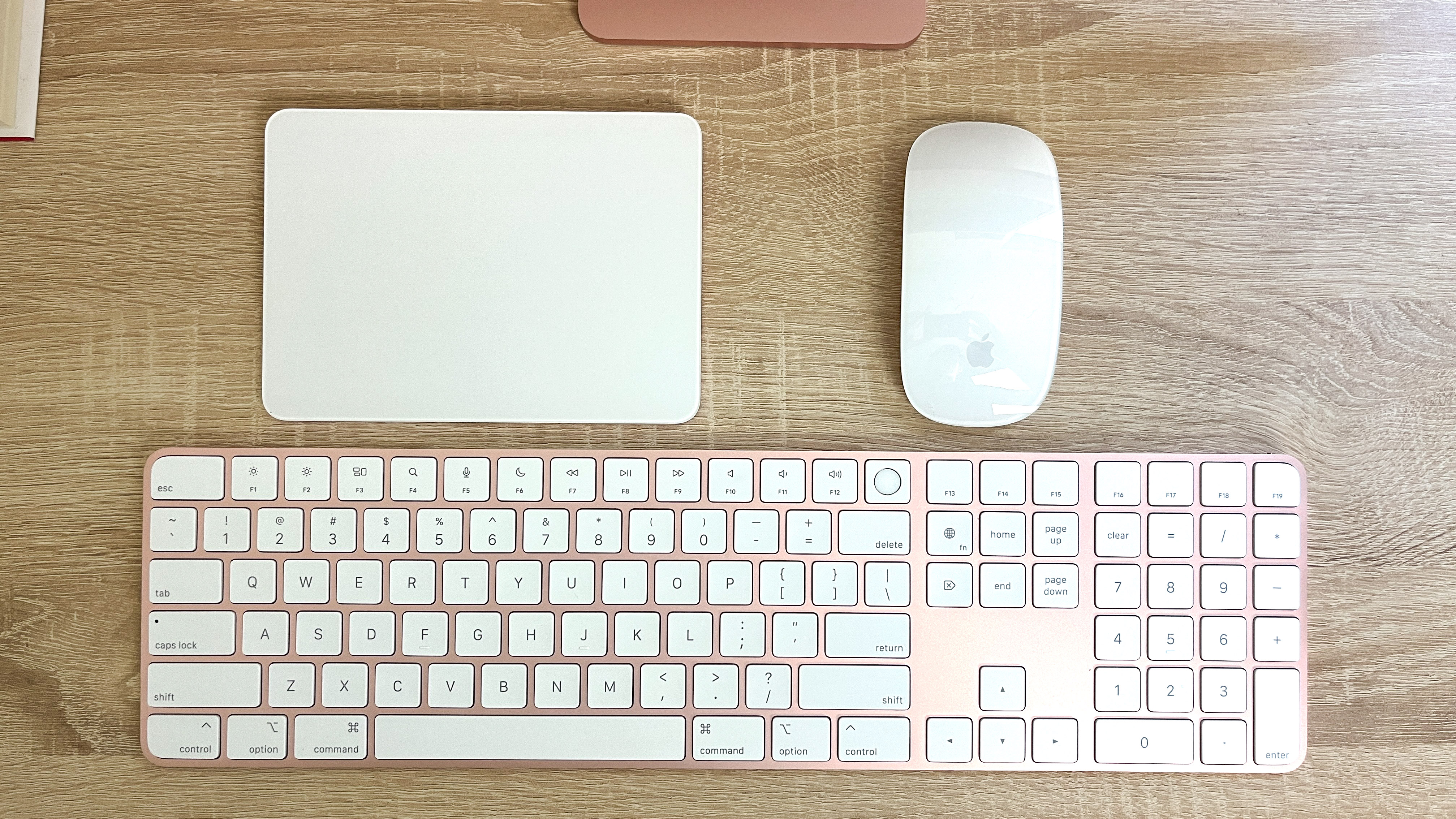
The pink iMac M3 Apple sent us for review purposes arrived with a fully upgraded M3 chip (8-core CPU, 10-core GPU), 24GB of RAM and 2TB of SSD storage, as well as a full complement of Magic Keyboard, Trackpad and Mouse. To buy the same package directly from Apple would cost you upgrades worth $2,700.
Apple iMac M3 review: Design
- Same design as the preceding iMac M1, but it still looks great
- The lack of height adjustment is still a crime against the tall
The new iMac M3 is effectively identical to its predecessor in terms of design, which isn't the worst thing since I quite liked the look of the 24-inch iMac M1.
It hasn't been that long since every iMac sported the same "big monitor wrapped in silver aluminum" aesthetic, so it's still a novel, welcome experience to walk into my living room in the morning and see a colorful pink computer sitting on my desk. And just like its predecessor, I'm a little surprised at how the paint job on the iMac M3 looks in person. The front of our review unit is quite a pale and understated pink, while the rear is so saturated it may as well be red.
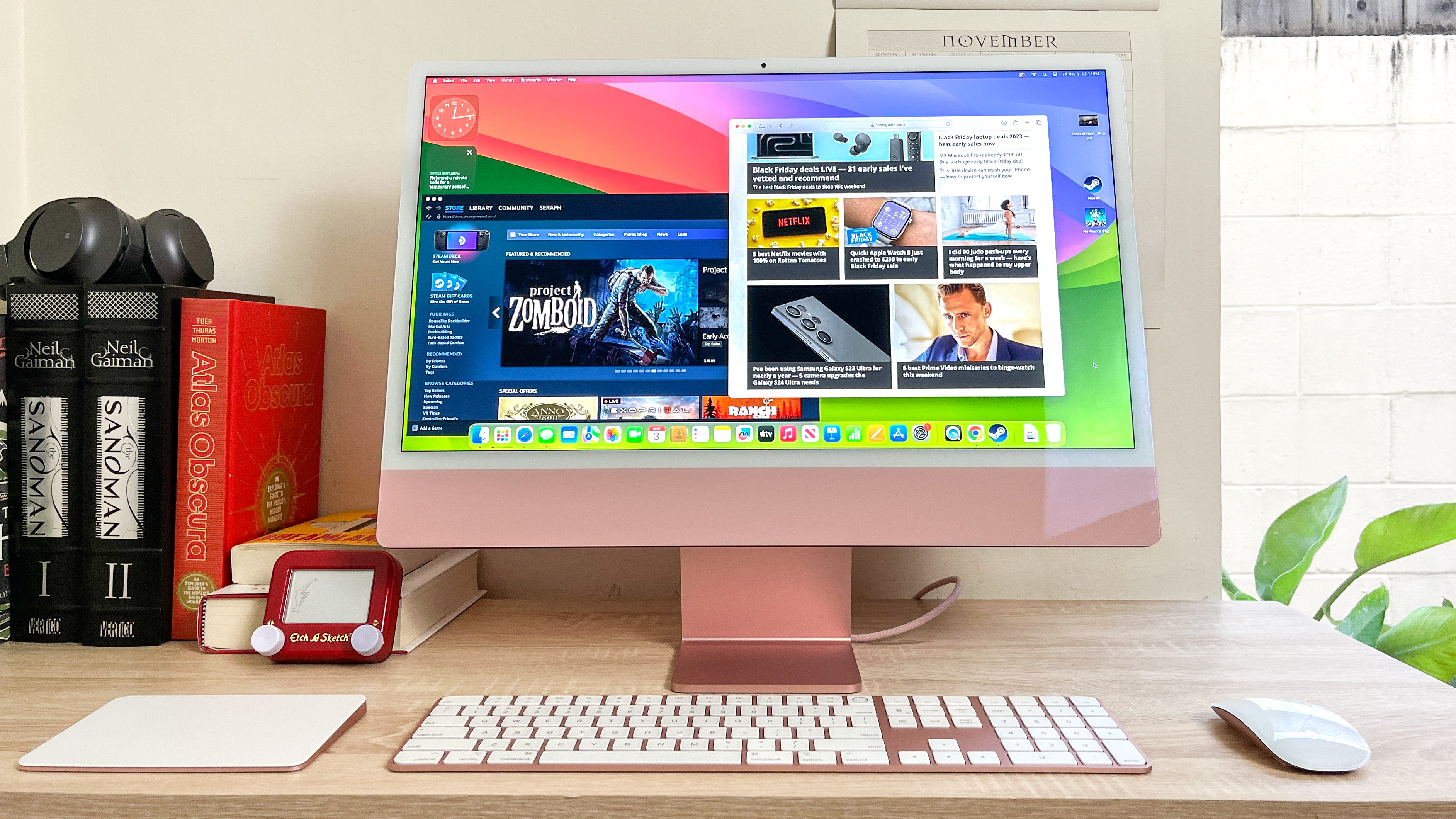
And the rear is where you'll find everything you'll need to interact with the iMac M3. The power button and ports are all mounted on the back of the display within (relatively) easy reach, and while you will have to blindly grope around to find a port if you don't want to spin the display around, the fact that you're limited to just a few Thunderbolt/USB-C ports helps cut down on that frustration since all the ports are basically the same and lined up together in one row along the rear left side.
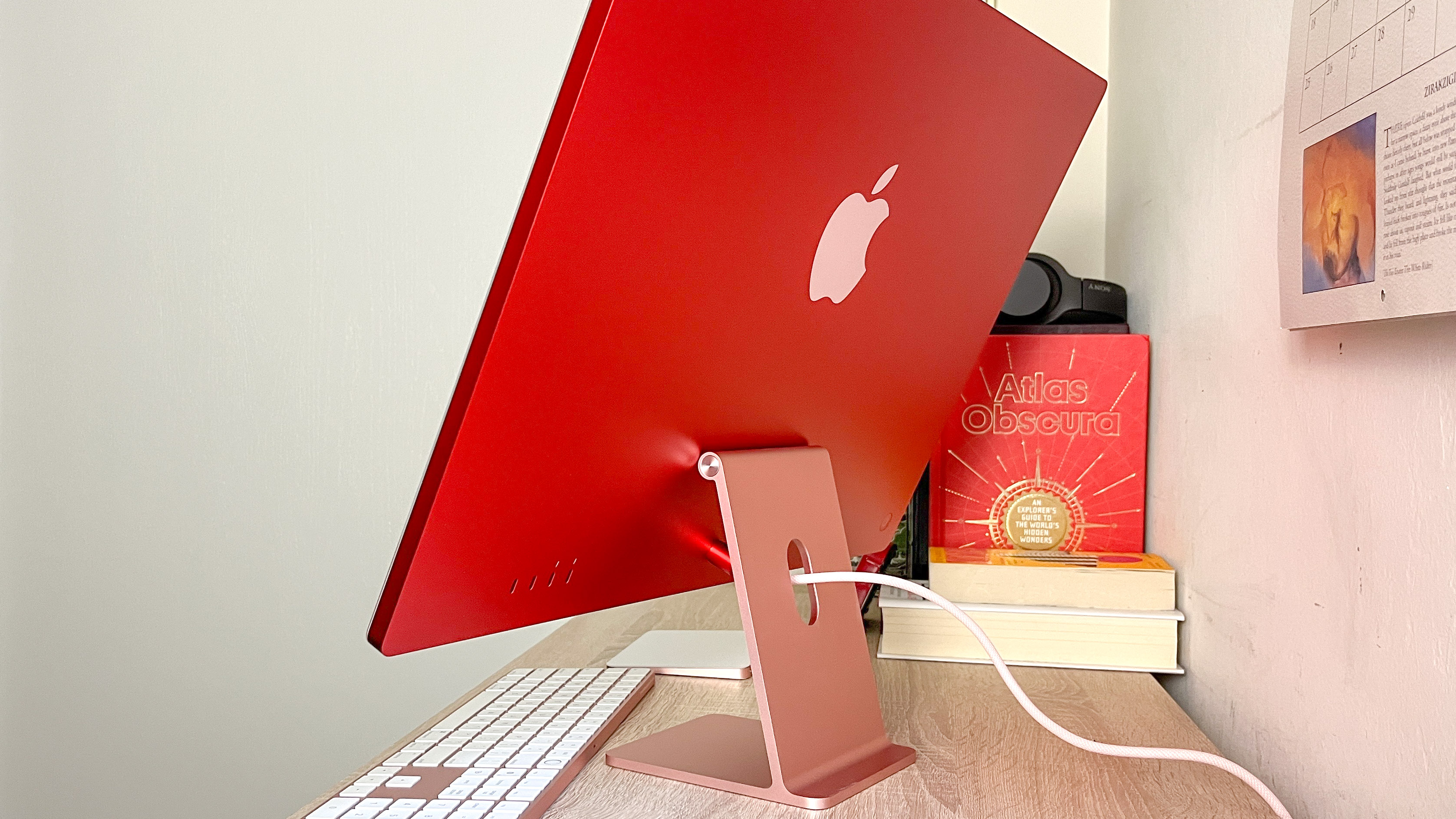
Unfortunately, the iMac M3 is still supported by the same aluminum stand that frustrated me on its predecessor. I find it frustrating because while there is a mechanism that lets you tilt the screen backward or forward by a slight amount, you can't adjust the height or rotation at all.
Having the ability to rotate the display a bit would have been a nice touch, but the lack of height adjustment just seems cruel to people outside a certain limited height range.
Okay, maybe "cruel" is a strong word for industrial design but look, I'm 6'4" and there's no way I could ever use the 24-inch iMac comfortably if I placed it on a desk with the mouse and keyboard in front of me. To use this Mac effectively I basically have to either construct an improvised tiered desk arrangement with the iMac balanced precariously on the thickest, sturdiest books I can find, or buy one with a VESA mount adapter and mount it on an arm or wall instead.
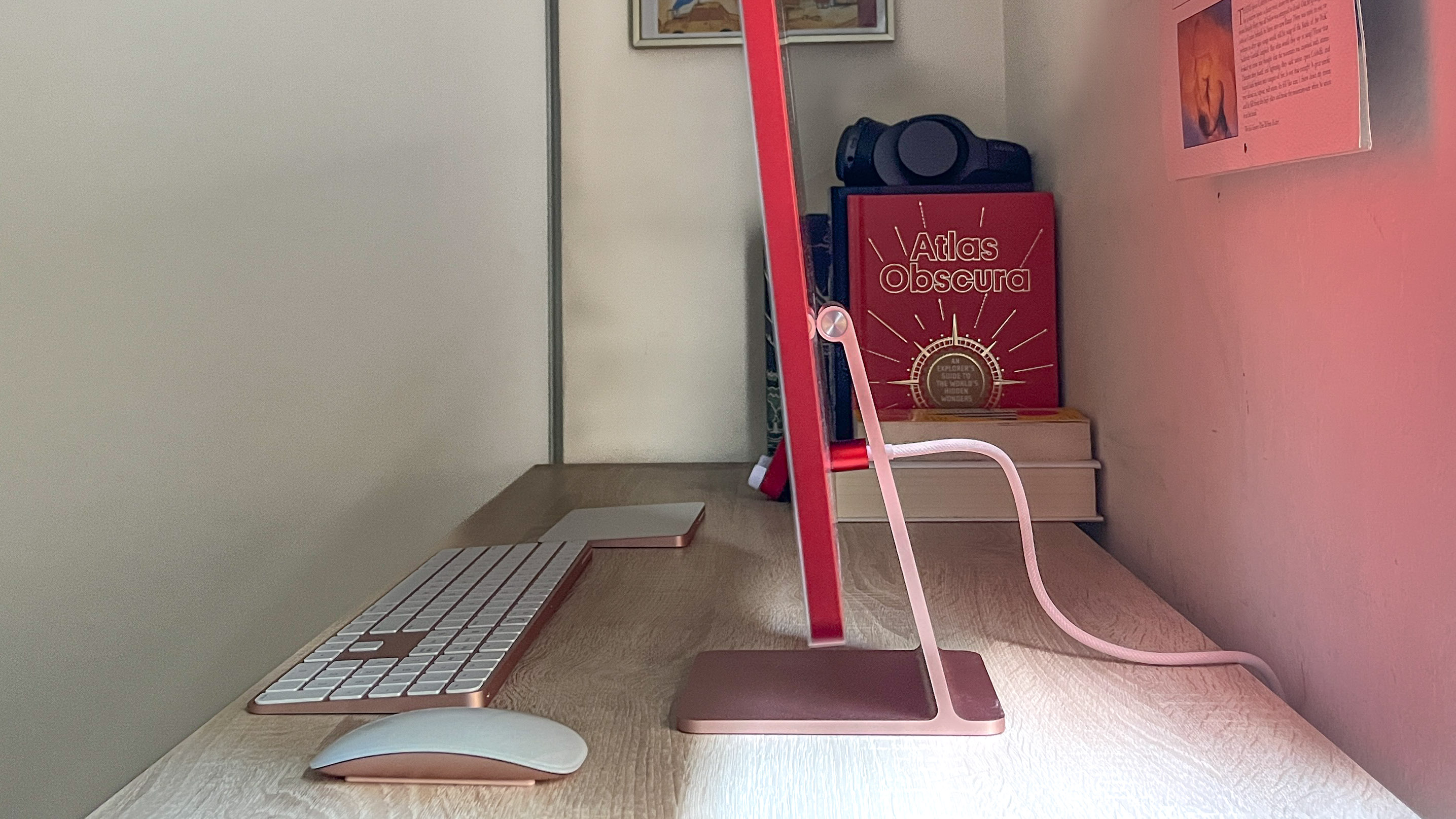
By comparison, the $400 1080p Dell touchscreen monitor I'm testing at the moment has both adjustable height and tilt. In fact, most monitors I've reviewed here at Tom's Guide offer some amount of height adjustment and rotation adjustment, so it kind of feels hurtful for Apple to not include an ergonomic feature that's so common.
Apple iMac M3 review: Display
- 4.5K display looks nice and bright, and our testing backs up Apple's claims
- Lack of HDR support is starting to feel painful in 2023
The 24-inch 4.5K (4,480 x 2,520 pixels) Retina display dominates the iMac M3, and it's just as eye-catching and attractive as it was on the 2021 model. I enjoyed my time playing games and streaming movies and TV shows on the iMac M3 because it's bright and colorful, and I never once noticed any graphical performance issues or screen problems.
However, the iMac's screen still doesn't support HDR (high dynamic range) or associated technologies like Dolby Vision, which is a little disappointing since it's now 2023 and those are becoming more common in movies, shows and games.
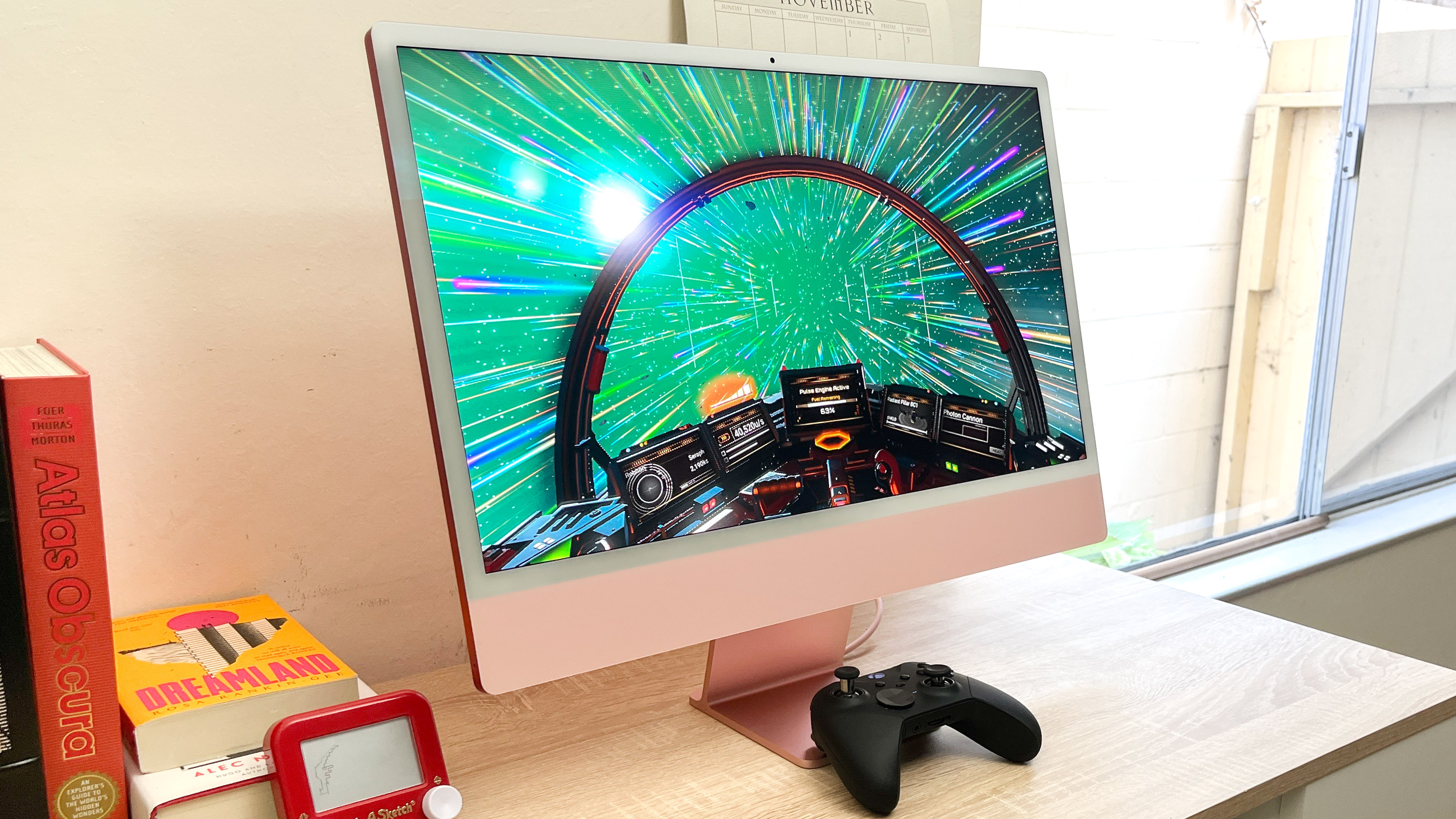
That's not to say the quality of those experiences is lacking on the iMac M3—far from it. I really enjoyed the way even streaming versions of films like The Green Knight looked on our review unit, and the viewing angles are so wide I feel like you could be watching this thing from the far corner of a living room and still see (and hear) what's happening on-screen.
Games also look great on it, and I wasn't stressing too much about HDR levels while playing through a few levels of Hades, though I did think some of the colors of space looked strangely sharp and bright while playing No Man's Sky.
Apple claims the display can achieve brightness levels of up to 500 nits, and a few rounds of testing in our lab proved the company isn't lying. When we pointed our Klein K10-A colorimeter at the screen, we found our iMac M3 review unit achieved an average brightness of 479 nits that peaked at 508 nits right smack dab in the center of the screen.
That's quite bright for a monitor, and right in line with Apple's marketing. The iMac M3's display is also pretty color-accurate, achieving 108.2% of the sRGB color gamut and 78.6% of the more demanding DCI-P3 color gamut with a Delta-E score of 0.2 (a score of 0 is best).
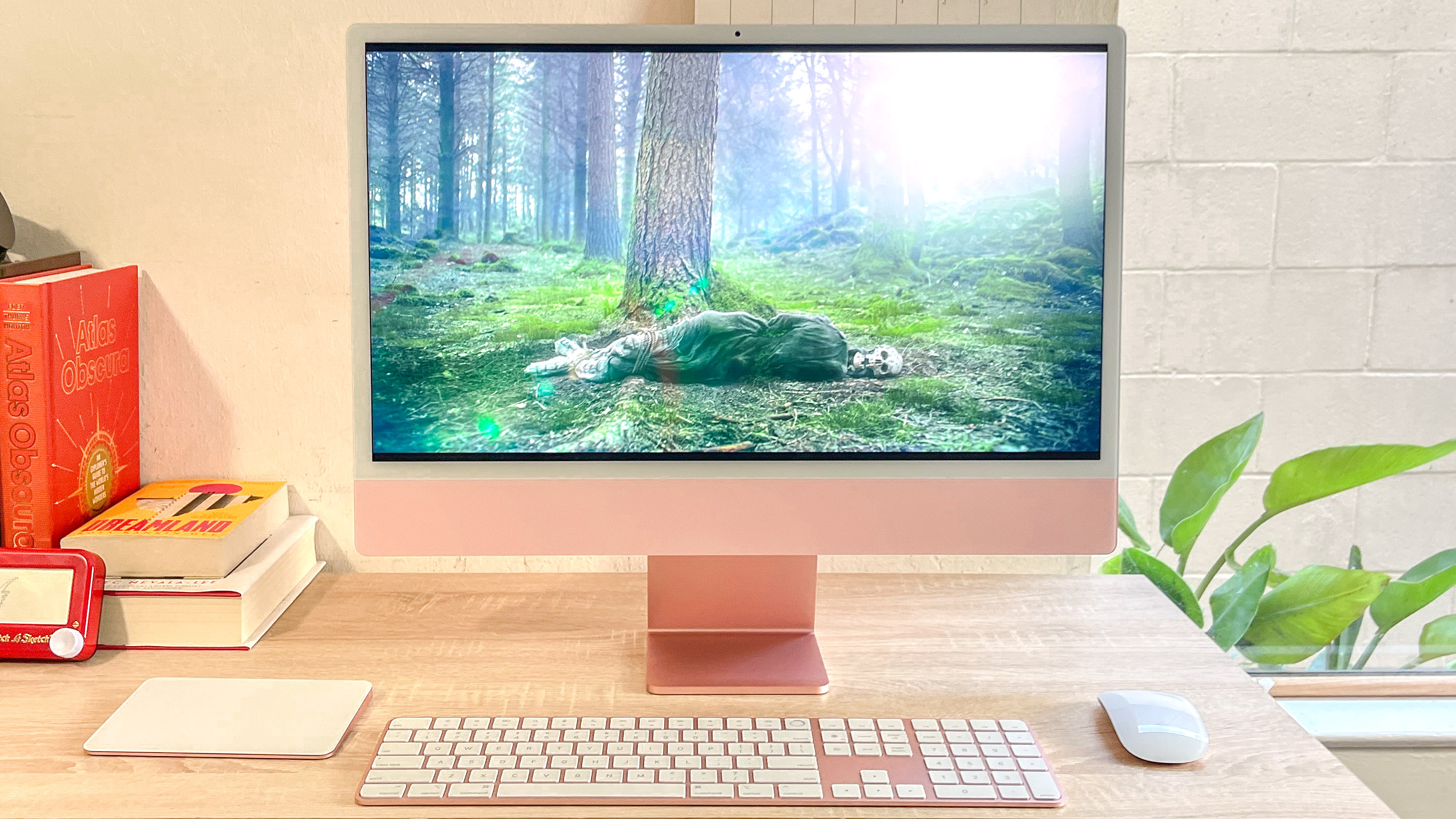
Regrettably, due to time constraints on the review, we didn't test the iMac 2021 as thoroughly as we've tested this 2023 M3 model, so I can't say for sure how much better or worse it is than the iMac M1's display. What I can tell you, though, is that this iMac M3 you can get for as little as $1,299 is brighter and more color-accurate than the HP Envy 34 all-in-one we tested last year, though the HP PC gets nearly as bright and can display more of the DCI-P3 color gamut.
I can also tell you that the new iMac is nearly as bright and color-accurate as the 27-inch Apple Studio Display ($1,599), which is worth knowing if you're thinking about how to buy the best desktop Mac setup for your needs. While Apple's standalone 5K display is still brighter and more vivid than the cheaper iMac M3, the gulf isn't huge.
Apple iMac M3 review: Ports and connectivity
- Still lacking in ports, especially on the $1,299 entry-level model
- Added support for Wi-Fi 6E and Bluetooth 5.3 is nice to have
As noted earlier, the port array on the iMac M3 is effectively identical to its predecessor. When I reviewed the iMac M1 in 2021 I said "the port selection is pretty anemic," and that remains true on the entry-level iMac M3, which sports just a pair of Thunderbolt 4 ports on the rear plus a headphone jack on the left-hand edge of the display.
Pay $200 or more to upgrade from the entry-level model and you'll get an additional pair of USB 3.0 Type-C added to the rear next to the Thunderbolt 4/USB 4 ports, as well as a Gigabit Ethernet port on the power adapter.
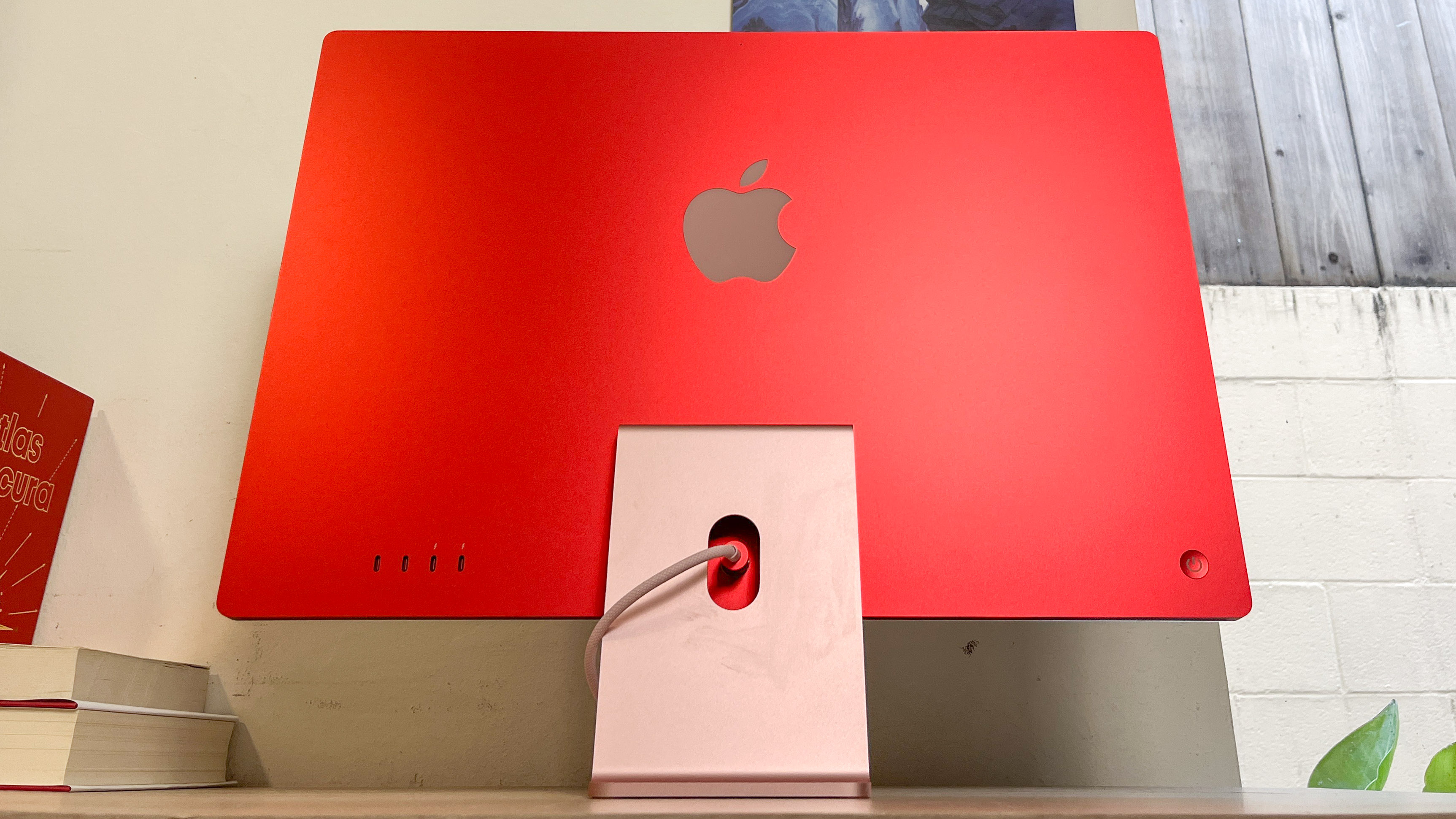
If you prefer to connect to the web wirelessly, you should know that the iMac M3 also supports up to Wi-Fi 6E and Bluetooth 5.3, an upgrade over the Wi-Fi 6 and Bluetooth 5 support available on the old iMac M1s from 2021.
While I wish the entry-level iMac offered a bit more for your money, I can't get too upset about the simplicity of the ports you get. While even the expanded four-port array you get on the more expensive models feels a bit lacking for power users, this is an all-in-one computer designed to sit on a desk—so you can make up for anything you really miss (like USB-A ports or an SD card reader) pretty easily by just buying an adapter, dongle or hub to also sit on said desk.
Apple iMac M3 review: Performance
- M3 chip is plenty fast for basic tasks, work and some light gaming
- Not as much of an improvement over the M2 as you might expect
The iMac has never been a beastly performance machine, and the addition of the new M3 chip hasn't changed that. But what it has done is improve an already speedy all-in-one, making it more capable of multi-tasking, gaming and getting things done than any iMac before it.
This new 2023 iMac M3 definitely blows its predecessor out of the water in terms of performance."
That said, let me set your expectations accordingly for what you get from this new iMac. In my time with our review unit and its maxed-out M3 chip (8-core CPU, 10-core GPU, 24GB RAM), I never felt limited or bogged down by the system's lack of resources, and I was able to seamlessly flit from task to task while keeping 20+ tabs open in Chrome and streaming music from iTunes with absolutely zero slowdown.
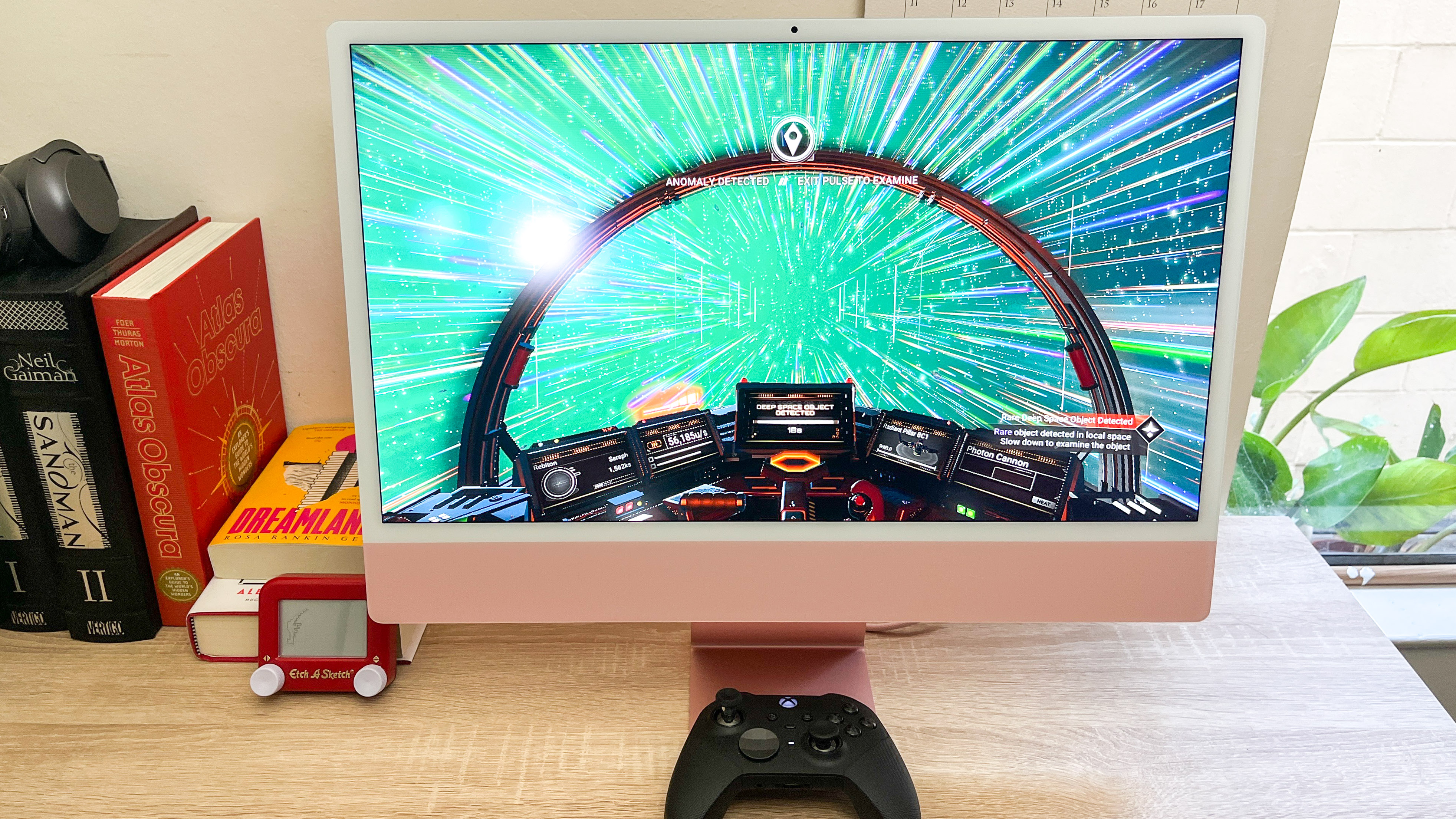
I had a pretty good time streaming movies and playing games, too, including modern releases like Lies of P and Total War: Warhammer III as well as classics like No Man's Sky. But while I enjoyed my time with those games well enough, they didn't look nearly as good on the iMac M3 as they do on the best gaming PCs.
Partly that's because the iMac doesn't support a lot of advanced graphics technologies, like variable refresh rate and HDR, that are commonly supported by modern game consoles and gaming PCs. Partly it's because the vanilla M3 chip just doesn't have the power to run many games well at the iMac's native 4.5K resolution.
So while the iMac M3 is clearly faster and more capable than its predecessor thanks to the newfound power and capabilities of the M3 chip, it's still not a PC I could recommend to someone who loves games and wants to enjoy them.
But as an all-purpose all-in-one, it's easy to recommend this iMac for families and students, because it's more than capable of handling tasks like browsing the web, doing homework, basic coding or photo/video editing, and light gaming.
I'm basing that not just on my own experience using the iMac M3 but also on the results of our performance testing. Since we had a bit more time with this iMac than with the M1 model I reviewed in 2021, we were able to run the new version through our performance testing lab and bring you a fuller report on how well this Mac performs under pressure.
And since I ran a few of these tests on the old 2021 iMac M1 myself, I can also tell you that this new 2023 iMac M3 definitely blows its predecessor out of the water in terms of performance. The M3 chip in our iMac 2023 review unit helped it earn 10,745 in the Geekbench 5 multi-core CPU benchmark, a solid score that's significantly higher than what the iMac M1 (7,684) was able to achieve.
It's also better than what the HP Envy 34 all-in-one ($1,999 to start, $2,639 as reviewed) we tested last year earned, though that Windows 11 PC had an older 11th Gen Intel Core i7 CPU compared to the newer 12th Gen Intel Alder Lake chips it now comes with.
But you know what's interesting? According to our testing, this iMac M3 scored very close to the Mac mini M2 Apple released at the start of the year. I'm not talking about the amped-up M2 Pro model we tested for our Mac mini M2 review, either—I'm saying that the $799 Mac mini M2 we also tested earlier this year, with its vanilla M2 chip, performed nearly as well in many of our tests as the newer and more expensive iMac M3 did.
To show you what I mean, here's a breakdown of some key performance tests we ran on the last three generations of desktop Macs packing Apple silicon.
As you can see from the results it's a story of slow and steady increases from M1 to M3, but the leap from the Mac mini M2 to iMac M3 is small in a few areas. Notably, while the M3 chip in our iMac M3 review unit does outperform the M2 in basically every test, the difference was pretty meager in terms of raw CPU performance and disk read/write speeds. Heck, in our video editing test, which times how long it takes a PC to transcode a 4K video file down to 1080p using Handbrake, the M2 Mac mini is just as fast as the new iMac M3.
I also had time to run a few gaming benchmarks on the iMac M3 during the review process, and the results back up my hands-on experience of this all-in-one as a Mac that's capable of playing games but not great at it.
Unfortunately, it's challenging for us to fully compare Mac gaming performance vs. the gaming performance of competing Windows machines because many of the games we use don't run natively on macOS. And since we haven't typically run many game tests on Mac desktops (as few can run them) I don't have a lot of old data to compare against the results of our iMac M3 game tests.
Still, I hope what I can share is of some use to you. As you can see, even when you knock a game down to 1080p (1,920 x 1,080 pixels) instead of playing it at the iMac's native 4.5K resolution, Apple's machine still has a hard time running modern games at decent framerates.
We were able to achieve a peak framerate of 35.9 frames per second when running Sid Meier's Civilization VI: Gathering Storm graphical benchmark at 1080p, for example, but if you play the same game at native resolution the result drops down to 20 FPS.
That's a bit disappointing because in my experience you need at least a solid 30 frames per second to feel good playing a game, and the iMac M3 struggles to achieve that in most games unless you knock the game settings way down. Heck, as you can see from the chart of results above, the new iMac actually ran Civ VI worse than the older, weaker Mac mini M2 we tested at the start of the year.
However, I would be remiss not to point out that the older M2 chip doesn't support the advanced gaming features the M3 does, like hardware-accelerated ray tracing and mesh caching. But if you really want a Mac for playing games, you might be better off investing in one of the new MacBook Pro M3 laptops with their beefier M3 Pro and M3 Max chips.
Apple iMac M3 review: Audio
- Six-speaker setup gets loud and sounds good, with decent bass
- Support for Dolby Atmos/Spatial Audio is nice
The six-speaker sound system (4 woofers, 2 tweeters) on the iMac M3 sounds great, delivering remarkably clear sound quality and some decent bass for your buck. The speakers also support Dolby Atmos and Apple's Spatial Audio tech, which uses directional filters and other tricks to make it seem like sound coming from the iMac is actually happening in 3D space around you. To my humble ears, it sounds like a louder, lusher, deeper soundscape, and I appreciated the extra bit of aural oomph on tracks from the likes of Huey Lewis & The News, Megan Thee Stallion and Rage Against the Machine.
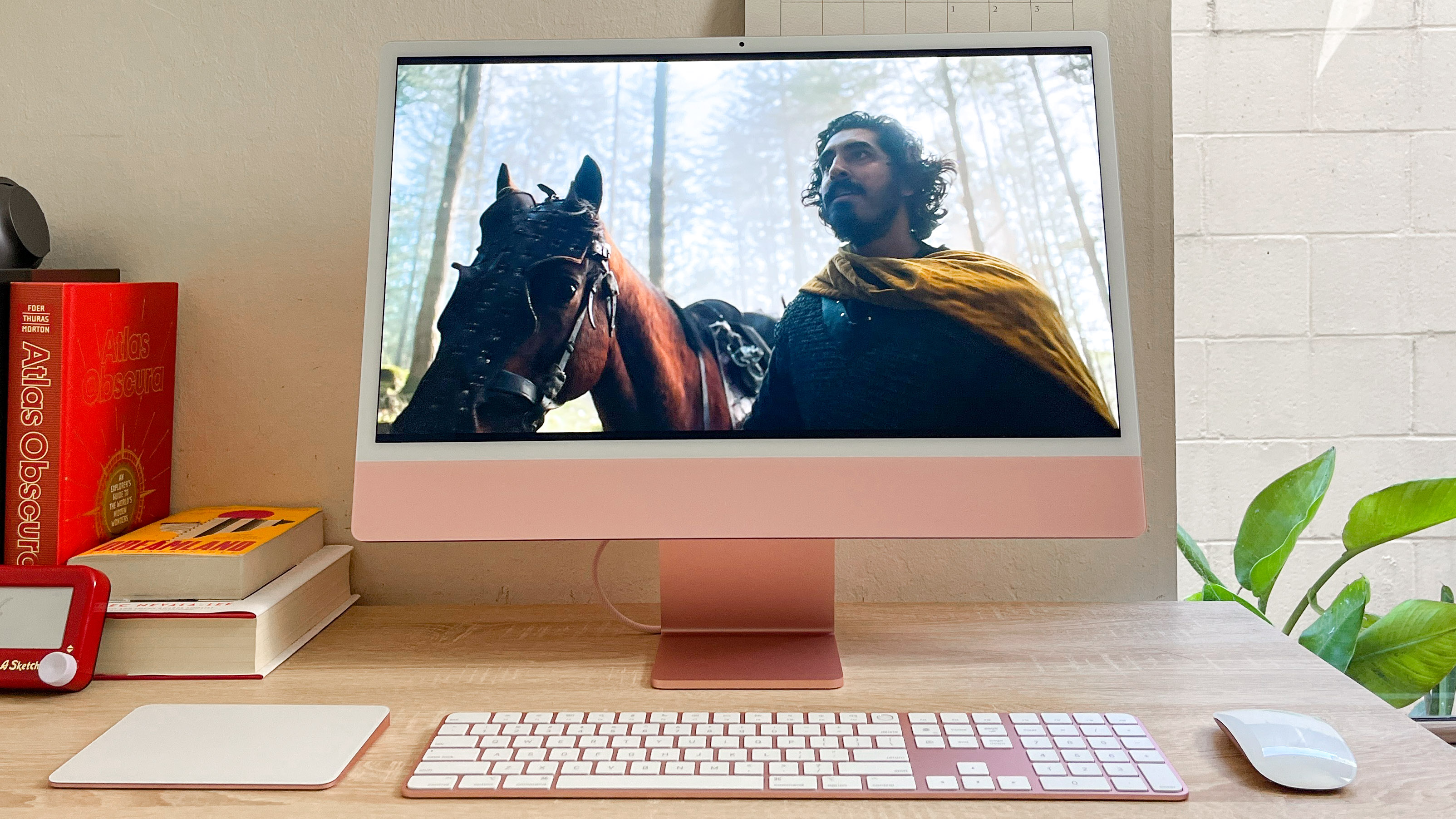
But even when listening to music and movies without Spatial Audio or Dolby Atmos support things sound clear and crisp. I'm too cheap to pay for the really high-quality stuff, but my favorite Spotify playlists also sounded great coming through the iMac's speakers. They get plenty loud, too, so you'll want to take care when leaning on the volume up key if you've got neighbors.
You can get better sound quality from a separate set of speakers or home speaker system, but sound this good from speakers built into an all-in-one is a rare treat. While there are some all-in-one PCs out there that do come with decent built-in speakers, like the HP Envy 34, few can match the sound quality of the iMac.
Apple iMac M3 review: Camera
- 1080p FaceTime camera works well
- Great sound quality on calls
The 1080p FaceTime camera mounted in the center of the top bezel on the iMac M3 is great for selfies and video calls, so you should have no trouble looking your best on Facetime, Zoom and other videoconferencing apps.
The triple-mic array built into the iMac seems to work quite well, and while I don't know that I'd recommend using it for tasks where audio quality really matters (like recording a podcast), it's more than good enough for basic tasks like FaceTiming with family, as I had no complaints about sound quality while doing just that.
The M3 chip also does all the same tricks as the old M1 did with even more power behind it, so in addition to the work it does to improve audio and picture quality you can count on access to features like the gesture-triggered video reactions which debuted with macOS Sonoma. (Here's how to use reactions in video calls on macOS Sonoma if you haven't yet.)
Apple iMac M3 review: Verdict
The 2023 iMac M3 is a great all-in-one PC that's easy to recommend if you're in the market for a new Mac, but less so if you're an iMac M1 owner looking to upgrade.
The 2023 model offers all the same benefits of its predecessor, from the elegant, colorful design to the eye-catching, remarkably thin display and great speakers. It was easy for me to recommend the 2021 M1 iMac to families, students, teachers and anyone who wanted a deskbound Mac for basic work and play because it offers so much in one compact package.
The iMac M3 is an even better deal because it still starts at $1,299 and now you're getting the extra features and added power of the M3 chip. That pays off in better performance when doing things like gaming or editing video, as well as better video quality on calls. If you're in the market for a new desktop Mac and you like the idea of an all-in-one, the iMac M3 is easy to recommend because you get decent performance at pretty much everything but serious gaming and creative work in a package that costs under $2,000.
That's a better deal than paying over $2,000 to pair a Mac mini M2 ($799) with an Apple Studio Display ($1,599), which would be another way to build a desktop Mac setup that, as you can see from our testing, would deliver similar performance to the iMac M3.
And that's why it's hard to heartily recommend existing iMac M1 users upgrade to this new M3 model: It's not that much faster or better, and it still has all the same weaknesses. It's disappointing that there's so little room to move the display on the stand, especially when so many competing Windows all-in-ones come with VESA mount brackets built in and offer more options to adjust display height, angle and tilt. And it just feels silly that you effectively have to pay Apple a $200 upcharge if you want one in purple.
But the extra ports and other amenities that come with it are worth it, and you do get what you pay for: a speedy Mac all-in-one that looks and sounds great, making it one of the best all-in-one computers of the year.







